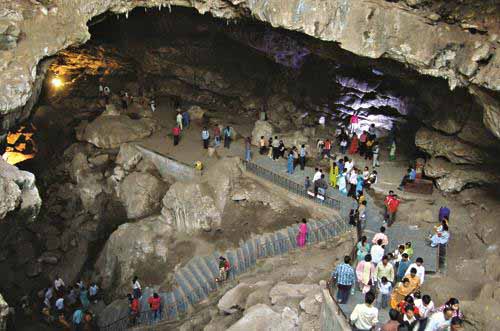Patal Bhuvaneshwar Cave Temple

Information of Patal Bhuvaneshwar Cave Temple, Pithoragarh, Uttarakhand
Patal Bhuvaneshwar Cave temple is an ancient naturally form lime stone caves in the Himalayas. It is believed to be the underground abode for nearly 330 crore known god and goddess of Hinduism lived in the ancient times. It is a breathtaking cave where the primary deity is Lord Shiva. Many have experienced a heavenly and hell like fell inside this caves. Many do have an experience of powerful energy inside these caves. It is also considered as a visit to this cave temple is equivalent as you have reached the char dhams of Lord Shiva. It is seen as hidden on the hills located at Pithoragarh district of Uttarakhand-State in North India.
Patal Bhuvaneshwar Cave Temple Religious Significance
The Hindus consider the Patal Bhuvaneshwar place as the abode for god and goddess since the ancient times. It is also said to be celestial place on earth. This is also considered as the getaway of Era's of the Hindu calendar which has 4 Eras and presently it is in the last Era which will see the destruction of animals, plants and humans on earth. Visiting this divine cave is more significant as visiting thousands of temples found scattered around the Indian sub continent. The primary deity is lord Shiva and is seen in the Shiva Linga form. There are also many other god and goddess found inside this caves and only few are worshiped which are easily accessible. The Adhi Shankara reopened this cave temple and made the Bhatnagar cast peoples to undertake the temple priest function and manage this temple. Nearly 20 generation has passed and is till dedicatedly conducting rituals and maintains this cave temple.
Patal Bhuvaneshwar Cave Temple Mythology & History
As per Hindu mythology this is a passage of time and seen as the once abode of gods and goddess in the creation of hell and heavens. The Sun Dynasty King Rituparna was the first human to discover these heavenly caves in 3600 BC after his visit the doors for the caves were closed for many Eras. It has got 4 doors and the 1st door named the Paapdwar was closed when Lankan king Ravan was dead. The 2nd door named Randwar was closed after the Kurekshetra War. Presently the doors of Mokshadwar and Dharamdwar are opened by the Sage Adhi Shankara in the 12th century AD for peoples to visit these holy caves and offer prayers and get blessing for the crores of god and goddess once abode here. The most significant feature of this cave is these is a small stone structure in the small Linga shape and are found growing in height by the past centuries. According to the Mana Skanda, this is a scale for the present kali Yuga. When this stone structure touches the ceiling or its nearby cave walls, that is the end of the kali Yuga and the end of this Era will be seen with vast destruction of lives on planet Earth.
Patal Bhuvaneshwar Cave Temple Architectural Significance
The Patal Bhuvaneshwar is the mountain caves which is are at altitude of 1350 meters. These are lime stone caves naturally formed with eroding away by spring waters. These caves are formed in a way that one can feel an immense natural power in the caves. Either these caves have breathtaking views. It has got a stretch of 160 meter in length and 90 feet depth under the mountains. Its accessibility is hard type and only the permissible limits are worshiped here. It is believed that there is a secret underground pathway that reaches to the Mount Kailas, which is the abode place for lord Shiva. There are many caves here and are interlinked in such a way that one can access with a guide who has complete knowledge of this caves. Inside this cave there is a small pond which is very cute to look with thick green tiny vegetations along with the pond water. For the conveyance of the pilgrims, there are electric lights and chain grips run across these caves. Thus the temple is well organized and is constructed keeping in mind all the necessity that would come up during the festival season and to ensure devotees enjoy their visit and can offer prayer peacefully.
- Andhra Pradesh Temples
- Assam Temples
- Bihar Temples
- New Delhi Temples
- Goa Temples
- Gujarat Temples
- Jammu and Kashmir Temples
- Karnataka Temples
- Kerala Temples
- Madhya Pradesh Temples
- Maharashtra Temples
- Odisha Temples
- Punjab Temples
- Rajasthan Temples
- Sikkim Temples
- Tamil Nadu Temples
- Telangana Temples
- Uttar Pradesh Temples
- Uttarakhand Temples
- West Bengal Temples